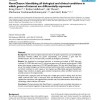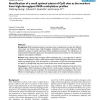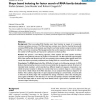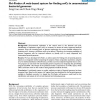BMCBI
2008
13 years 11 months ago
2008
Background: Inferring gene regulatory networks from data requires the development of algorithms devoted to structure extraction. When only static data are available, gene interact...
BMCBI
2008
13 years 11 months ago
2008
Background: The amount of gene expression data in the public repositories, such as NCBI Gene Expression Omnibus (GEO) has grown exponentially, and provides a gold mine for bioinfo...
BMCBI
2008
13 years 11 months ago
2008
Background: DNA methylation patterns have been shown to significantly correlate with different tissue types and disease states. High-throughput methylation arrays enable large-sca...
BMCBI
2008
13 years 11 months ago
2008
Background: There has been a lot of interest in recent years focusing on the modeling and simulation of Gene Regulatory Networks (GRNs). However, the evolutionary mechanisms that ...
BMCBI
2008
13 years 11 months ago
2008
Background: Quantitative characterization of the topological characteristics of protein-protein interaction (PPI) networks can enable the elucidation of biological functional modu...
BMCBI
2008
13 years 11 months ago
2008
Background: Bioinformatics data analysis toolbox needs general-purpose, fast and easily interpretable preprocessing tools that perform data integration during exploratory data ana...
BMCBI
2008
13 years 11 months ago
2008
Background: Most non-coding RNA families exert their function by means of a conserved, common secondary structure. The Rfam data base contains more than five hundred structurally ...
BMCBI
2008
13 years 11 months ago
2008
Background: Chromosomal replication is the central event in the bacterial cell cycle. Identification of replication origins (oriCs) is necessary for almost all newly sequenced bac...
BMCBI
2008
13 years 11 months ago
2008
Background: As an alternative to the frequently used "reference design" for two-channel microarrays, other designs have been proposed. These designs have been shown to b...
BMCBI
2008
13 years 11 months ago
2008
Background: The heterokonts are a particularly interesting group of eukaryotic organisms; they include many key species of planktonic and coastal algae and several important patho...





